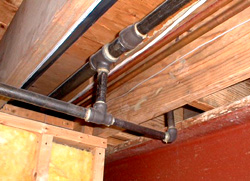 Many people use Schedule 40 PVC pipe and that choice is - OSHA ALERT - potentially dangerous. Under pressure, PVC can explode when it becomes brittle with age or exposure to UV light or when struck by an object. But there are a lot of shops piped with Schedule 40 PVC. If you choose to use it against all advice, at least consider the stronger Schedule 80 pipe and fittings, keep the pipe protected from things that may fall on it and don't hammer near it. PVC is smooth inside which means less pressure drop from friction.
Many people use Schedule 40 PVC pipe and that choice is - OSHA ALERT - potentially dangerous. Under pressure, PVC can explode when it becomes brittle with age or exposure to UV light or when struck by an object. But there are a lot of shops piped with Schedule 40 PVC. If you choose to use it against all advice, at least consider the stronger Schedule 80 pipe and fittings, keep the pipe protected from things that may fall on it and don't hammer near it. PVC is smooth inside which means less pressure drop from friction.There are ABS pipes, Dura-Plus and Chem-Aire, that are rated for compressed gas use. The cost is roughly twice that of Schedule 80 PVC. Dura-Plus comes in a metric size (colored blue) and an industrial size, colored gray; the blue pipe cannot be threaded for standard pipe threads. Chem-Aire pipe is green.
Schedule 40 black iron pipe is a popular choice and is very sturdy and durable. It's also heavy and awkward to install and will rust inside, not only adding scale to the air, but increasing friction and causing increasing pressure drops over time. Galvanized Schedule 40 is a better choice, but more cumbersome to work with and also requires some specials tools.
Copper pipe is lighter and easier to install, and comes in three types. Type L is identified with blue markings and Type K is identified with green markings; both are strong enough to use. Type M is marked red and is not recommended since it is only rated for 125 PSI; that won't leave much of a margin for error. Copper is smooth inside which means less pressure drop from friction; this matters for long runs of pipe.
Of course, you could always use stainless steel pipe and compression fittings or even the very cool (but ridiculously expensive) Garage Pak system which uses a coated aluminum pipe and special fittings. All that expense does buy a product that is easy to use.
There is also Compressed Air Systems which sells coated aluminum pipe. This looks like what I saw at Harbor Freight.
Comments